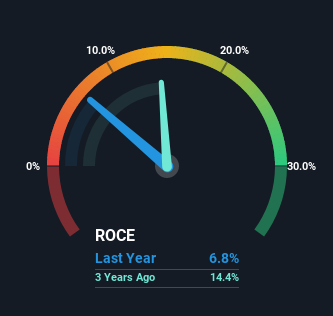- Brazil
- /
- Food and Staples Retail
- /
- BOVESPA:PNVL3
Investors Could Be Concerned With Dimed Distribuidora de Medicamentos' (BVMF:PNVL3) Returns On Capital

There are a few key trends to look for if we want to identify the next multi-bagger. Firstly, we'll want to see a proven return on capital employed (ROCE) that is increasing, and secondly, an expanding base of capital employed. If you see this, it typically means it's a company with a great business model and plenty of profitable reinvestment opportunities. Although, when we looked at Dimed Distribuidora de Medicamentos (BVMF:PNVL3), it didn't seem to tick all of these boxes.
What Is Return On Capital Employed (ROCE)?
Just to clarify if you're unsure, ROCE is a metric for evaluating how much pre-tax income (in percentage terms) a company earns on the capital invested in its business. The formula for this calculation on Dimed Distribuidora de Medicamentos is:
Return on Capital Employed = Earnings Before Interest and Tax (EBIT) ÷ (Total Assets - Current Liabilities)
0.068 = R$118m ÷ (R$2.5b - R$763m) (Based on the trailing twelve months to June 2022).
Thus, Dimed Distribuidora de Medicamentos has an ROCE of 6.8%. Ultimately, that's a low return and it under-performs the Consumer Retailing industry average of 9.8%.
View our latest analysis for Dimed Distribuidora de Medicamentos

In the above chart we have measured Dimed Distribuidora de Medicamentos' prior ROCE against its prior performance, but the future is arguably more important. If you'd like to see what analysts are forecasting going forward, you should check out our free report for Dimed Distribuidora de Medicamentos.
What Does the ROCE Trend For Dimed Distribuidora de Medicamentos Tell Us?
On the surface, the trend of ROCE at Dimed Distribuidora de Medicamentos doesn't inspire confidence. Around five years ago the returns on capital were 20%, but since then they've fallen to 6.8%. Although, given both revenue and the amount of assets employed in the business have increased, it could suggest the company is investing in growth, and the extra capital has led to a short-term reduction in ROCE. And if the increased capital generates additional returns, the business, and thus shareholders, will benefit in the long run.
On a side note, Dimed Distribuidora de Medicamentos has done well to pay down its current liabilities to 30% of total assets. So we could link some of this to the decrease in ROCE. Effectively this means their suppliers or short-term creditors are funding less of the business, which reduces some elements of risk. Some would claim this reduces the business' efficiency at generating ROCE since it is now funding more of the operations with its own money.
Our Take On Dimed Distribuidora de Medicamentos' ROCE
Even though returns on capital have fallen in the short term, we find it promising that revenue and capital employed have both increased for Dimed Distribuidora de Medicamentos. These growth trends haven't led to growth returns though, since the stock has fallen 15% over the last five years. So we think it'd be worthwhile to look further into this stock given the trends look encouraging.
If you'd like to know about the risks facing Dimed Distribuidora de Medicamentos, we've discovered 1 warning sign that you should be aware of.
For those who like to invest in solid companies, check out this free list of companies with solid balance sheets and high returns on equity.
New: Manage All Your Stock Portfolios in One Place
We've created the ultimate portfolio companion for stock investors, and it's free.
• Connect an unlimited number of Portfolios and see your total in one currency
• Be alerted to new Warning Signs or Risks via email or mobile
• Track the Fair Value of your stocks
Have feedback on this article? Concerned about the content? Get in touch with us directly. Alternatively, email editorial-team (at) simplywallst.com.
This article by Simply Wall St is general in nature. We provide commentary based on historical data and analyst forecasts only using an unbiased methodology and our articles are not intended to be financial advice. It does not constitute a recommendation to buy or sell any stock, and does not take account of your objectives, or your financial situation. We aim to bring you long-term focused analysis driven by fundamental data. Note that our analysis may not factor in the latest price-sensitive company announcements or qualitative material. Simply Wall St has no position in any stocks mentioned.
About BOVESPA:PNVL3
Dimed Distribuidora de Medicamentos
Sells medicines, perfumeries, personal care and beauty products, cosmetics, and dermo-cosmetics in Brazil.
Undervalued with excellent balance sheet and pays a dividend.
Market Insights
Community Narratives




